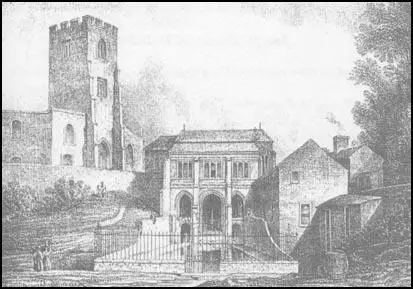St Winifred's Well
St. Winifred's Well was an important place for pilgrims to visit during the Middle Ages. The story is told of how in the 7th century a young prince, Caradoc, visited Tegeingle near the mouth of the River Dee. Caradoc saw a pretty young girl called Winifred and made advances towards her. Winifred rejected and then ran towards the church. Caradoc, furious for being treated in this way, chased after her and cut off her head with a sword.
The head rolled down the hill towards the church. Winifred's father, Beuno, was just leaving the church and realizing what had happened, "cursed Caradoc so that he fell dead". Beuno lifted the head, wrapped it in his cloak and returned to Mass, where he asked the people to help him with their prayers for Winifred. He then joined the "head to her body and she at once revived, and afterwards bearing only a red threadlike mark around her throat."
Legend has it that where Winifred's head had fallen "the stones surrounding the fountain were stained forever with her blood, and the blood falling in the water coloured also the moss that grows there and which has the perfume of frankincense, though some say of violets."

A well was built where Winifred's head fell and people believed in the Middle Ages that its water had a curative quality. Therefore people visited St. Winifred's Well seeking physical help rather than a pilgrimage of penance.
On 23rd November, 1851, Pope Pius IX granted indulgences to pilgrims who visited St. Winifred's Well. This increased the number of visitors but on 5th January, 1917, disaster struck when the spring, which had been bubbling at the rate of twenty-one tons a minute, went suddenly dry. The reason for this was that tunnelling by a local lead-mine company, had caused the water to drain away into the River Dee. Later that year the lead-miners had managed to divert another underground stream to restore the supply of water.
Primary Sources
(1) Celia Fiennes, wrote about her visit to St. Winifred's Well in her book The Journeys of Celia Fiennes (1685)
It seems the Saint they do honour to in this place must bear them out in all things, they tell of many lamenesses and aches and distempers which are cured by it; its a cold water and clear and runs off very quick so that it would be pleasant refreshment in the summer to wash oneself in it, but its shallow not up to the waist so its not easy to dive and wash in.
I saw abundance of the devout papists on their knees all round the well; poor people are deluded into an ignorant blind zeal and to be pitied by us that have the advantage of knowing better and ought to be better. There is some small stones of a reddish colour in the well said to be some of St Winifred's blood also, which the poor people take out and bring to the strangers for curiosity and relicts, and also moss about the banks full of great virtue for every thing - but its a certain game to the poor people, every one gives them something for bringing them moss and the stones.
At Holly Well they speak Welsh, the inhabitants go barefoot and bare legged. A nasty sort of people, their meat is very small here, the mutton is no bigger than little lamb, and what of it is very sweet; their wine good being near the sea side and are all well provided with fish.
(2) Daniel Defoe wrote about her visit to St. Winifred's Well in his book A Tour Through The Whole Island of Great Britain (1727)
We came to Hollywell. The stories of this Well of S. Winifrid are, that the pious virgin, being ravished and murdered, this healing water sprung out of her body when buried; but this smells too much of the legend, to take up any of my time; the Romanists indeed believe it, as is evident, from their thronging hither to receive the healing sanative virtue of the water, which they do not hope for as it is a medicinal water, but as it is a miraculous water, and heals them by virtue of the intercession and influence of this famous virgin, St Winifrid; of which I believe as much as comes to my share.
